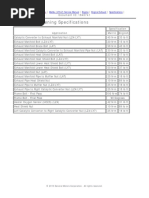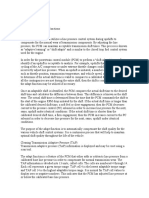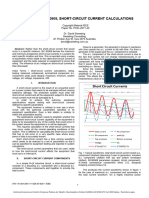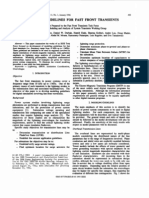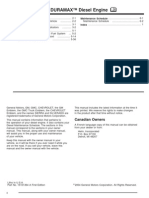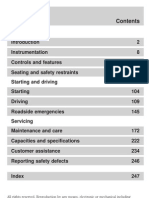Understanding IEC 60909
Uploaded by
Mauricio Toro CasallasUnderstanding IEC 60909
Uploaded by
Mauricio Toro CasallasUnderstanding IEC60909
Terminology/definitions
Fig. 1
A fault current waveform illustrating AC as well as DC decay
Withstand current
= also referred to as making currents
Interrupting duties
= also referred to as breaking short-circuit duties.
AC Decrement
= a symmetrical short-circuit current that has a time-varying change from
peak to peak during the fault (i.e. the peak to peak distance varies with
time)
Near to generator
short-circuits
= fault currents which have an AC decrement
Far from generator
short-circuits
= fault currents exhibiting no AC decrement
= initial symmetrical short-circuit current at the fault location. If there was
no AC decay, then this current would be constant in that the peak-to-peak
values would not change with time. If there is only DC offset (or decay)
then the peak-to-peak distances remain the same but are not symmetrical
w.r.t. the horizontal axis. With only AC decay, the peak-to-peak distances
remain symmetrical w.r.t. the horizontal axis but they decrease with time to
a steady state value.
Ik
= steady state current. This is the conventional symmetrical fault current
when the AC and DC decrements have disappeared. For far from
generator faults, Ik = I k.
IDC
= DC Current. The exponentially decaying DC component of the fault
current waveform due to the inductance of the system. It is determined by
the point on the voltage waveform at which the fault occurs. Note this is
Page 1 of 3
not
a current that can be measured, rather it is calculated. It is a
mathematical
model of a decaying transient inherent in the fault current
waveform.
Ip
= Peak Current. This is the maximum peak of i(t) as illustrated in Fig. 1.
The theoretical maximum is 2 2 I k as already shown. It is the half-cycle
peak as expressed by equation 2.13.
Ib
= Breaking Current. A current duty intended for the rating of the current
interrupting device for when the contacts part. For far contributions,
breaking duty equals initial symmetrical current, I k. For near contributions
special multipliers need to be applied to account for the AC decrement. Ib
has no DC decrement but Ib(asym) considers both AC and DC decrement.
Ib is a symmetrical r.m.s. current 55ms (for example) down the line
from I k.
IDC
Ib2
Ib(asym)
(1)
Where IDC is the DC current calculated for the same t as Ib.
Summary
The short circuit current for an RL circuit in which the pre-load current can be ignored is :
i( t )
iac ( t )
2 V
sin(
Z
idc ( t )
) e T
) sin(
A.
(2)
Where,
2 V
sin(
Z
iac ( t )
) A , idc ( t )
R2
X2
arctan
2 V
sin(
Z
L
R
arctan
) e
X
R
t
T
A,
and
= impedance angle
= initial phase displacement (or offset) angle of the source voltage, v(t)
The time constant, T, for the circuit is given by, T
L
R
X
R
X
s. For a threephase fault, L
f R
and R are the positive sequence inductance and resistance of the system. For an earthfault, L and R
are derived from ZTOT = RTOT + jXTOT = Z1 + Z2 + Z0 .
Page 2 of 3
The maximum possible offset occurs when
i( t )
2 V
sin(
Z
2 V
sin(
Z
= 90, i.e. i( t )
t 90 ) e
t
T
or
90 ) e T A.
The asymmetrical r.m.s. equivalent of the transient current, Ir.m.s., is given by
4
Ir.m.s. ( t )
I AC 1 2 e
f t
R
K t I AC A . Where K( t )
1 2 e
f t
R
. K is called the
asymmetry factor. The asymmetrical r.m.s. fault current varies from 3IAC when t = 0 to IAC when t
is large where IAC = InitSymRMS. Note that the asymmetrical rms current does not form part of
IEC60909.
The peak current, Ip, as per IEC 60909 is given by Ip
both is when X/R approaches
giving ip(max)
Ik"
1.02 0.98 e
2 Ik " or ip(max)
Page 3 of 3
2 I AC .
3R
X
. The limit for
You might also like
- 2008 Chevrolet Malibu Service Repair Manual PDF100% (1)2008 Chevrolet Malibu Service Repair Manual PDF19 pages
- (Ebook) - (Drugs) - (Methamphetamine) - (Nazi Labs) - (How To Make Crystal Meth)100% (4)(Ebook) - (Drugs) - (Methamphetamine) - (Nazi Labs) - (How To Make Crystal Meth)7 pages
- ETAP FAQ - Governor Limit Checking in Transient Stability Studies100% (1)ETAP FAQ - Governor Limit Checking in Transient Stability Studies1 page
- Simulations of Lightning Impulse Residual Voltage Test of Surge Arresters in Matlab-Simulink100% (1)Simulations of Lightning Impulse Residual Voltage Test of Surge Arresters in Matlab-Simulink6 pages
- Assessing P28 Guidelines For Renewable Generation ConnectionsNo ratings yetAssessing P28 Guidelines For Renewable Generation Connections6 pages
- 11.applying - IEC - 60909 - Short-Circuit - Current - Calculations 2023No ratings yet11.applying - IEC - 60909 - Short-Circuit - Current - Calculations 20236 pages
- Analysis and Optimization of 132KV Grid Using ETAP PDFNo ratings yetAnalysis and Optimization of 132KV Grid Using ETAP PDF6 pages
- Flicker Analysis and Methods For Electric Arc Furnace Flicker (EAF) MitigationNo ratings yetFlicker Analysis and Methods For Electric Arc Furnace Flicker (EAF) Mitigation6 pages
- Protection Coordination Study - Draft Final - Rev6100% (1)Protection Coordination Study - Draft Final - Rev658 pages
- Why Is X/R Ratio Important?: Figure 1 Sample Simple Circuits With Different X/R Ratios100% (1)Why Is X/R Ratio Important?: Figure 1 Sample Simple Circuits With Different X/R Ratios3 pages
- Modeling Guidelines For Fast Front TransientsNo ratings yetModeling Guidelines For Fast Front Transients14 pages
- Article Dynamic Modeling of Three Phase Transformer100% (1)Article Dynamic Modeling of Three Phase Transformer5 pages
- Protection of Three Winding Transformer enNo ratings yetProtection of Three Winding Transformer en10 pages
- Design of Electrical System Based On Load Flow Analysis Using ETAP For IEC Projects100% (1)Design of Electrical System Based On Load Flow Analysis Using ETAP For IEC Projects6 pages
- Transient Overvoltages On Ungrounded Systems From Intermittent FaultsNo ratings yetTransient Overvoltages On Ungrounded Systems From Intermittent Faults40 pages
- Procedure For IEEE 1584 Based Arc Flash Calculations - Electric Arc PDFNo ratings yetProcedure For IEEE 1584 Based Arc Flash Calculations - Electric Arc PDF3 pages
- Short Circuit According To The IEC 60909 - Open Electrical100% (1)Short Circuit According To The IEC 60909 - Open Electrical14 pages
- Calculation For Short Circuit Current Calculation Using IEC IEEE Standard PDF100% (1)Calculation For Short Circuit Current Calculation Using IEC IEEE Standard PDF11 pages
- 3 Winding Transformer Commissioning TestNo ratings yet3 Winding Transformer Commissioning Test5 pages
- EPTD - W8-L2 - Corona in Transmission Lines100% (1)EPTD - W8-L2 - Corona in Transmission Lines16 pages
- Calculation Size of Neutral Earthing Transformer (NET) : Generator DetailsNo ratings yetCalculation Size of Neutral Earthing Transformer (NET) : Generator Details6 pages
- Application of Undervoltage Protection To Critical Motors PDFNo ratings yetApplication of Undervoltage Protection To Critical Motors PDF6 pages
- Applying IEC 60909 Fault Current Calculations PDF100% (1)Applying IEC 60909 Fault Current Calculations PDF6 pages
- Traveling Wave Fault Location in Protective RelaysNo ratings yetTraveling Wave Fault Location in Protective Relays14 pages
- ATPDraw Simulation of Switching TL500kV-00No ratings yetATPDraw Simulation of Switching TL500kV-008 pages
- Sequential Motor Dynamic Acceleration and Re-Acceleration Simulations: Comparison of ETAP®No ratings yetSequential Motor Dynamic Acceleration and Re-Acceleration Simulations: Comparison of ETAP®6 pages
- Complex Short Circuit MVA Method For Power PDFNo ratings yetComplex Short Circuit MVA Method For Power PDF4 pages
- Simulation of Some Power System, Control System and Power Electronics Case Studies Using Matlab and PowerWorld SimulatorFrom EverandSimulation of Some Power System, Control System and Power Electronics Case Studies Using Matlab and PowerWorld SimulatorNo ratings yet
- VSC-FACTS-HVDC: Analysis, Modelling and Simulation in Power GridsFrom EverandVSC-FACTS-HVDC: Analysis, Modelling and Simulation in Power GridsNo ratings yet
- Transients in R-L Circuits: Fault AnalysisNo ratings yetTransients in R-L Circuits: Fault Analysis5 pages
- DiagnosticsProcedureOnPowerStroke6.0L 11.2010100% (1)DiagnosticsProcedureOnPowerStroke6.0L 11.20107 pages
- 2005DuramaxManual Like s10 Diesel Engines PDFNo ratings yet2005DuramaxManual Like s10 Diesel Engines PDF78 pages
- "6.0L Power Stroke Diagnostics": Technical Article67% (3)"6.0L Power Stroke Diagnostics": Technical Article4 pages
- 2000 Super Duty F-250, F-350, F-450, F-550 Owner Guide100% (7)2000 Super Duty F-250, F-350, F-450, F-550 Owner Guide256 pages



